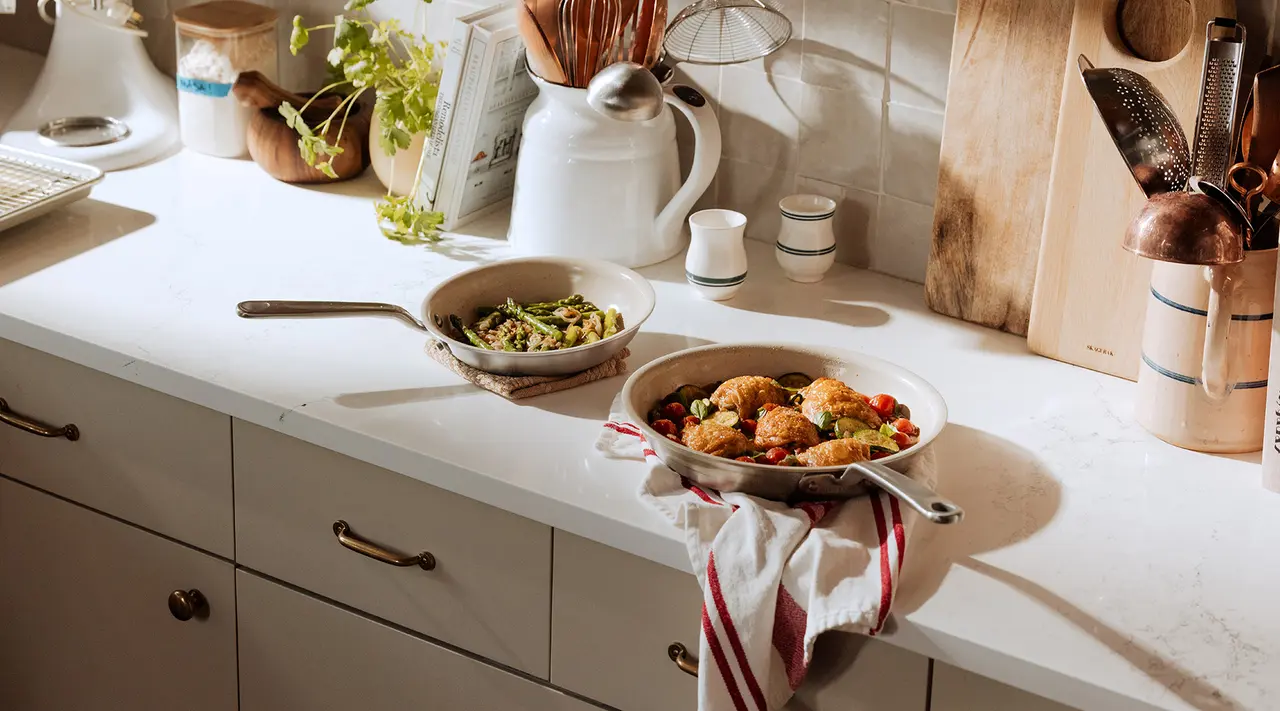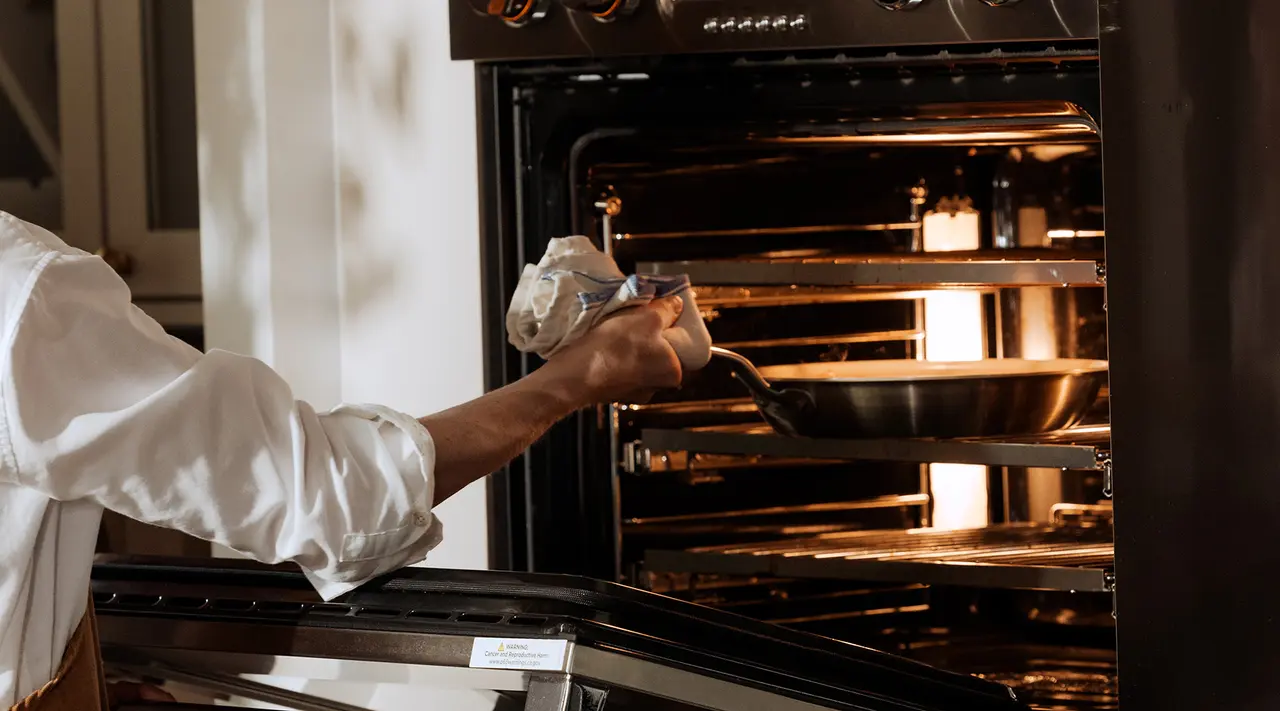Ceramic cookware is often touted as a greener alternative to non stick cookware—a pan produced without harmful chemicals that gives you a frictionless cooking surface on which to fry eggs, cook fish, and have an easy cleanup at the end. Add in the Instagram effect, and you’ve probably seen certain ceramic pots and pans with designer colors and on-trend aesthetics.
But like most trends, it's important to do a little research to make sure what you’re buying is both well made and will live up to the hype. One consideration with ceramic cookware is how much heat it can handle—and if ceramic can go in the oven. Read on to learn more about ceramic pans and the answer to that question.
Understanding Ceramic Coated Pans

Ceramic cookware has nothing to do with that quirky mug you scored from your local ceramicist. Instead, these pans offer an alternative to traditional coated non stick cookware, with a naturally-derived coating on top of a metal base (usually stainless steel or aluminum), rendering the pans water- and oil-resistant. The “ceramic” name comes from the coating’s glossy, enamel-like appearance.
The biggest benefit of this ceramic coating is, of course, the smooth, non stick cooking surface it provides. Where traditional non stick has a storied (and complicated) past with chemicals in their coating, ceramic has always been made without any of the big ones like PFAS, lead, and cadmium. Many people are turning to ceramic as a coated alternative to traditional non stick cookware.
Like other non stick skillets, you can use these pans for many recipes, including delicate items like eggs, but also other everyday tasks like reheating leftovers or sauteing a simple side of vegetables. Ceramic is a good choice if you’d like to cook with less fat, too, since its non stick surface requires less cooking oil.
Can Ceramic Pans Go in the Oven?

Given the wide variety of ceramic pans in the world, whether or not ceramic cookware can go in the oven varies greatly. Construction materials and quality of the coating are two big factors that determine if ceramic cookware can go in the oven.
Generally, manufacturers of ceramic cookware will indicate whether or not it’s oven safe, typically on the website, packaging materials, or the pot and pans themselves. Our CeramiClad™ Collection is proudly oven safe up to 550F, though it should rarely need to be used with that high of a temperature.
For the most part, it's best to avoid high temperatures (above 500 degrees) with ceramic cookware, since high temperatures more quickly degrade the non stick coating.
Ceramic cookware—like other non stick pots and pans—can also be prone to warping (also called thermal shock) if exposed to extreme temperature changes, so it’s best to preheat the pots and pans before putting them into the oven (if you’re making something that starts on the stove and finishes in the oven, that will suffice). Once you’re done cooking, allow the cookware to come back to room temperature before cleaning with warm, soapy water—never put ceramic cookware in the dishwasher.
Ceramic cookware is less durable (meaning it doesn't last quite as long) than other materials like carbon steel or stainless steel, but it’s still possible to find high-quality, relatively durable ceramic cookware. Look for pots and pans made with 5-ply stainless steel or hard-anodized aluminum, like our CeramiClad™ Collection.
Factors Influencing Oven Safety
This goes without saying, but we’ll say it anyway: only pots and pans with non-plastic components can go in the oven. If your ceramic cookware has plastic anywhere on it, including the handle, it is not oven safe. As mentioned above, the pan’s construction materials matter too—thicker pots and pans will withstand oven temperatures without warping, and a high quality coating won’t degrade as quickly. Still, you should take care to avoid metal utensils or any material that could scratch the surface as you’re cooking and dishing up.
Proper cleaning and storage are important for all your cookware, but especially ceramic’s more delicate coating. Always wash by hand using a soft sponge or dish cloth—avoid anything too abrasive like steel wool or rough scouring pads.
Once clean, let the pan air dry or wipe it down with a towel. If you’re storing your pans by stacking them, make sure to put a dish towel, trivet, or Pan Protector between them to avoid scratching.
Benefits of Oven-Safe Ceramic Cookware

Having ceramic cookware that can transition from stove to oven offers extra convenience when cooking things like stews, braises, and pot pies. Ceramic cookware shines when making egg dishes, too, like a frittata that you start on the stove and finish in the oven. Whatever dish you’re making, cleaning up at the end is made all the easier thanks to the non stick surface.
Ready to Cook?
Ceramic-coated pots and pans can be oven safe, provided you’re buying high quality cookware. If you prefer the convenience of non stick cookware, it’s worth expanding your collection in this category—especially with our CeramiClad™ Collection.































